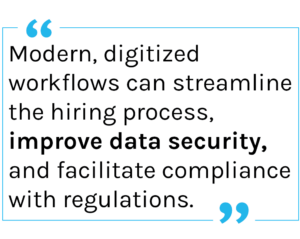Tips and Best Practices for Higher Ed HR Compliance
Compliance is a key and complicated part of the role of human resources teams, and this is especially true in higher education. The HigherEd industry is highly regulated, at both the state and federal levels, making the job even more complicated for HR teams that work on a college or university campus. Noncompliance, even when unintentional, can have serious negative consequences for an institution, ranging from legal and financial (including fines and penalties) to reputational. That’s why ensuring compliance is such an important part of the role of higher education human resources teams. Read on below for some top tips and best practices for ensuring higher ed HR compliance.
Challenges faced by Higher Ed
There are several HR challenges faced by HigherEd that are unique, making the world of compliance even more complicated. They include:
- Regulatory complexity: Higher education institutions must navigate a web of federal and state regulations, including Title IX, FLSA, and ADA, which can be particularly intricate in an academic setting. Teams must navigate these human resources rules, regulations, and procedures to remain compliant.
- Faculty and staff diversity: Ensuring compliance with equal employment opportunity laws while managing a diverse workforce of faculty and staff presents unique challenges.
- Student employment: Compliance with regulations related to student employment, such as work-study programs and internships, adds another layer of complexity.
- Varying types of employees: Colleges and universities may have to deal with different regulations for faculty, staff, part-time faculty, hourly workers, summer employees, and more—campuses have a greater variety of types of workers than many other organizations.
Higher Education HR Compliance Best Practices
- Stay informed about regulations: Regularly monitor federal and state regulations to ensure compliance with labor laws, as they often evolve in response to changes in the workforce.
- Document policies and procedures: Properly document all company policies and procedures, and ensure easy access for employees. This includes creating an accessible and easy-to-navigate employee handbook.
- Regularly audit HR policies: Conduct regular HR audits to ensure that HR policies, such as leave policy, non-discrimination policy, and compensation policy, are compliant.
- Establish specialized HR departments: Consider establishing specialized HR departments within colleges to address the
 unique objectives of different divisions.
unique objectives of different divisions. - Promote diversity, equity, and inclusion: Initiate regular conversations on campus among staff and departments to promote diversity and inclusion, enabling the institution to move into a more inclusive environment.
- Leverage technology: Use HR compliance software to track regulatory requirements and obligations. Modern, digitized workflows can streamline the hiring process, improve data security, and facilitate compliance with regulations. HR compliance software can centralize and automate compliance-related tasks, such as tracking employee certifications and managing leave policies, thereby reducing the risk of non-compliance.
- Standardization: Standardize hiring and interviewing procedures to ensure fair hiring.
- Training and education: Provide thorough orientation for new hires that includes their responsibilities for HR compliance and clearly explains policies for reporting noncompliance. Provide ongoing training to HR staff, faculty, and supervisors on compliance requirements and best practices. Create higher education compliance checklists to stay on top of things.
- Get leadership involved: Encourage executive leaders to champion ethics and compliance, and provide ways for employees to report unethical activity.
- Collaboration across departments: Encourage collaboration between HR, legal, and academic departments to ensure a comprehensive approach to compliance.
The Role of Technology in Higher Ed HR Compliance
When it comes to HigherEd HR compliance, the right technology is key. A platform built for your HR needs supports your team in so many ways, including:
- Efficiency and streamlining: Technology removes administrative burdens, eliminates duplicate processes, and centralizes information, making data insights more accessible. This streamlines communication, increases security, and automates tasks, thereby saving time for HR professionals.
- Data management: HR technology allows for the centralization and management of vast amounts of information related to faculty and staff recruitment, onboarding, compensation, performance management, and compliance training. This helps HR professionals find more insight into information like retention, growth, and historical data about positions and job duties, and keep that information secure and accessible for compliance purposes.
- Strategic role of HR: By leveraging technology, HR professionals can engage in more strategic work, such as employer
 branding to attract talent, and providing insights into retention and growth, rather than being bogged down by manual processes and administrative tasks.
branding to attract talent, and providing insights into retention and growth, rather than being bogged down by manual processes and administrative tasks. - Data-driven decision making: HR technology provides access to critical data, which is essential for financial forecasting, succession planning, and staff performance management, enabling HR teams to make informed, data-driven decisions.
Luckily, PeopleAdmin has the technology your team needs to keep track of employee information, stay audit-ready, and manage your employees. Built just for HigherEd, PeopleAdmin’s tools have the customizable, flexible workflows you need to tackle any HR challenge. Check out:
- Employee Records: With all documents in one portal and visibility into processes, you’ll ensure compliance and reduce time-consuming records management tasks. Plus, digital forms management means all faculty and staff have self-service, mobile-friendly access to HR forms like change-of-address to FMLA documents without requesting them in person or via email.
- Applicant Tracking System: In our powerful ATS, real-time dashboards with easy-to-understand visuals make it easy to interpret your data. Standard reports help you stay EEO compliant and audit-ready based on federal and state regulations. Customizable reports can be automated so you can share information with key stakeholders on your own schedule.
- Insights: Insights helps you uncover key insights into EEO compliance, budget planning, balanced hiring, faculty and staff hiring and retention, and more. And with automated reporting, you can easily schedule specific, easy-to-understand reports for institution leaders and key stakeholders — empowering data-based decision making across the institution.